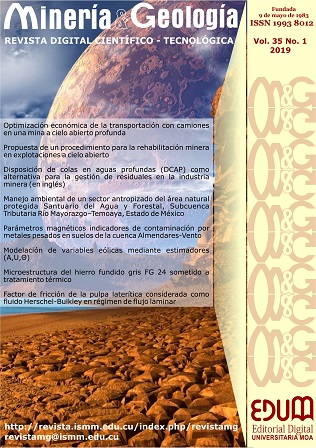Disposición de colas en aguas profundas (DCAP) como alternativa para la gestión de residuales en la industria minera (en inglés)
Palabras clave:
residuales mineros, minería sostenible, disposición de colas, minería en el mar, contaminación marina.Resumen
El artículo persigue aclarar cómo los sistemas de disposición de colas en aguas profundas se han utilizado a escala mundial como prácticas mineras alternativas. El trabajo constituye una revisión de estudios de casos donde se emplea esta tecnología. En la investigación se consultaron las fuentes de información disponibles, lo cual incluyó: reportes de casos, artículos científicos, tesis, así como informes realizados por autoridades competentes. Mediante la aplicación de métodos empíricos y teóricos para la investigación se logra exponer los principios de operación e impactos ambientales fundamentales de esta tecnología en el medio marino, así como una evaluación de los principales casos en el mundo.Descargas
Citas
Asmund, G.; Broman, P. and Lindgren, G. 1994: Managing the environment at the Black Angel mine, Greenland. International Journal of Surface Mining, Reclamation and Environment, 8(1): 37-40.
Dold, B. 2014: Submarine Tailings Disposal (STD) —A Review. Minerals, 4(3): 642-666.
Elberling, B.; Asmund, G.; Kunzendorf, H. and Krogstad, E. 2002: Geochemical trends in metal-contaminated fiord sediments near a former lead-zinc mine in West Greenland. Applied Geochemistry, 17(4): 493-502.
Ellis, D. 1994: Screening Criteria for Submarine Tailings Disposal, Victoria. Canada: British Columbia.
Ellis, D. and Ellis, K. 1994: Very deep STD. Marine Pollution Bulletin, 28(8): 472-476.
Ellis, D. 2006: A short history of submarine tailings placement (STP) in the context of lessons learned for subsequent sustainable development at a mining site (Update #8). Manuscript Report: 42.
European Integrated Pollution Prevention and Control Bureau. Consulta: 15 ene 2015. Disponible en: http://www.eippcb.jrc.ec.europa.eu
Gaceta Oficial de la República de Cuba. 1995: Ley No. 76 de Minas. La Habana.
Joint Group Of Expert On The Scientific Aspects Of Marine Environmental Pollutions (GESAMP). 2016: In: GESAMP International Workshop on the Impacts of Mine Tailings in the Marine Environment. Rep. Stud. GESAMP No. 94, 84 p.
Hofer, T. 2008: Marine Pollution: New Research. New York: Nova Science Publishers, Inc. 451 p.
Hughes, D.; Shimmield, T.; Black, K. and Howe, J. 2015: Ecological impacts of large-scale disposal of mining waste in the deep sea. Scientific Reports, 5: 1-11.
International Maritime Organization (IMO). 2013: International Assessment of Marine and Riverine Disposal of Mine Tailings. In: 34th Meeting of the London Convention and the 7th Meeting of the London Protocol. London, UK (Vol. 1).
Koski, R. A. 2012: Metal dispersion resulting from mining activities in coastal environments: A pathways approach. Oceanography, 25(2): 170–183.
Lottermoser, B. 2007: Mine Wastes: Characterization, Treatment and Environmental Impacts. 3 ed. Berlin Heidelberg: Springer Verlag. 410 p.
May, J. 2014: Mitigation of Environmental Impacts by implementing Deep Sea Tailings Placement – a Case Study of the Moa Mining District in Cuba. Hans-Juergen Gursky (Tutor). Bachelor Thesis. Institute of Geology and Paleontology. TU Clausthal. 63 p.
Moorhead, C. 2013: Technical Report on the Lihir Property in Papa New Guinea, Newcrest Mining. Consulta: 1 feb 2015. Disponible en: http://www.newcrest.com.au/media/resource_reserves/Technical%20Reports/Technical_Report_on_the_Lihir_Property_December_31_2013-Final.pdf
Moran, R. 2008: Riverine and sub-sea disposal of tailings and associated wastes from mining operations around the world: the need for detailed assessment and effective control. Scientific Group of the London Convention. Consulta: 20 feb 2015. Disponible en: http://www.sjofartsverket.se/pages/15453/31-INF14.pdf
Poling, G. and Ellis, D. 1995: Importance of geochemistry: the Black Angel lead-zinc mine, Greenland. Marine Georesources & Geotechnology, 13(1-2): 101-118.
Poling, G.; Ellis, D.; Murray, J.; Parson, T. and Pelletier, C. 2002: Underwater Tailing Placement at Island Copper Mine – A success story. Society for Mining, Metallurgy and Exploration, Littleton, Colorado, USA. 250 p.
Servicio de Información Mundial sobre Energía. Consulta: 3 ene 2015. Disponible en: http://www.wise-uranium.org
Shimmield, T.; Black, K.; Howe, J.; Hughes, D. and Sherwin, T. 2010: SAMS, Final Report, Independent Evaluation of Deep-Sea Mine Tailings Placement (DSTP) in PNG. Oban, UK.
Singhal, R. K. 2009: Mining and the Environment: From Ore to Metal. International Journal of Mining, Reclamation and Environment, 23(4): 241.
Skei, J. 2006: The dilemma of waste management in the mining industry – criteria for sea disposal. Mineralproduksjon, 3 B1-B4, Løvenstad, Norway.
Vogt, C. 2012: International assessment of marine and riverine disposal of mine tailings. In: 34th Meeting of the London Convention and the 7th Meeting of the London Protocol, London, UK (Vol. 1). Consulta: 15 dic 2014. Disponible en: http://www.craigvogt.com/links/Mine_Tailings_Marine_and_Riverine_Disposal.pdf
Publicado
Cómo citar
Número
Sección
Derechos de autor 2019 Yosbanis Manuel Cervantes-Guerra, Allan Pierra-Conde, Jacob Mai, Hans Jürgen-Gursky, Jo Van-Caneghem, Carlo Vandecasteele

Esta obra está bajo una licencia internacional Creative Commons Atribución-NoComercial 4.0.
Los autores que publican en esta revista están de acuerdo con los siguientes términos:
- Licencia Creative Commons Atribución-NoComercial permite que el beneficiario de la licencia tenga el derecho de copiar, distribuir, exhibir y representar la obra y hacer obras derivadas para fines no comerciales siempre y cuando reconozca y cite la obra de la forma especificada por el autor o el licenciante.
- Los autores pueden establecer por separado acuerdos adicionales para la distribución no exclusiva de la versión de la obra publicada en la revista (por ejemplo, situarlo en un repositorio institucional o publicarlo en un libro), con un reconocimiento de su publicación inicial en esta revista.
- Se permite y se anima a los autores a difundir sus trabajos electrónicamente (por ejemplo, en repositorios institucionales o en su propio sitio web) antes y durante el proceso de envío, ya que puede dar lugar a intercambios productivos, así como a una citación más temprana y mayor de los trabajos publicados (Véase The Effect of Open Access) (en inglés).
- Lo anterior debe realizarse siempre sobre el artículo ya publicado por Minería y Geología.
La revista permite que los autores tengan los derechos de autor sin restricciones
La revista permite que los autores conserven los derechos de publicación sin restricciones










